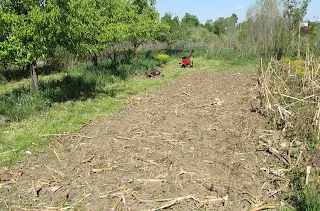The last of the strawberry plants are in the ground.
I bought 100 plants for $35 because twenty-five plants cost $20. My plan was to tuck them in beneath the trees in the orchard as part of the ground-cover shoot-out. I had 45 plants left over.
I hate waste
I tilled up a small patch just south of the pear orchard. The soil is not great. It is too clayey to make digging potatoes fun.
I spaced the rows 42" apart, which is my standard given the width of my tiller. According to the internet, I was advised to put the plants 18"-to-24" apart in the rows. Well, I have a lot more land than strawberry plants, so I spaced them 36" apart. That gave me three, 40' rows.
I am sure they will fill in. I just don't know if it will be this year.
Commercial growers tend to plant the patch one year, harvest the next and then rip it out. This primarily to avoid the build up of leaf and root diseases and to keep virus loads reasonable.
Home growers can milk a patch much longer. The game plan is to mow the leaves after fruit harvest to minimize sources of leaf diseases. It is considered good practice to catch the leaves and either compost them or use them for mulch FAR from the strawberry patch. The next step is to till the patch and only leave a very narrow untilled strip.
Strawberry plants tend to crowd themselves. Our job as managers is to kill off the surplus plants and only leave one viable plant every 12"-to-24" within the row. Given water and a modest amount of fertility they will fill in.

No comments:
Post a Comment
Readers who are willing to comment make this a better blog. Civil dialog is a valuable thing.